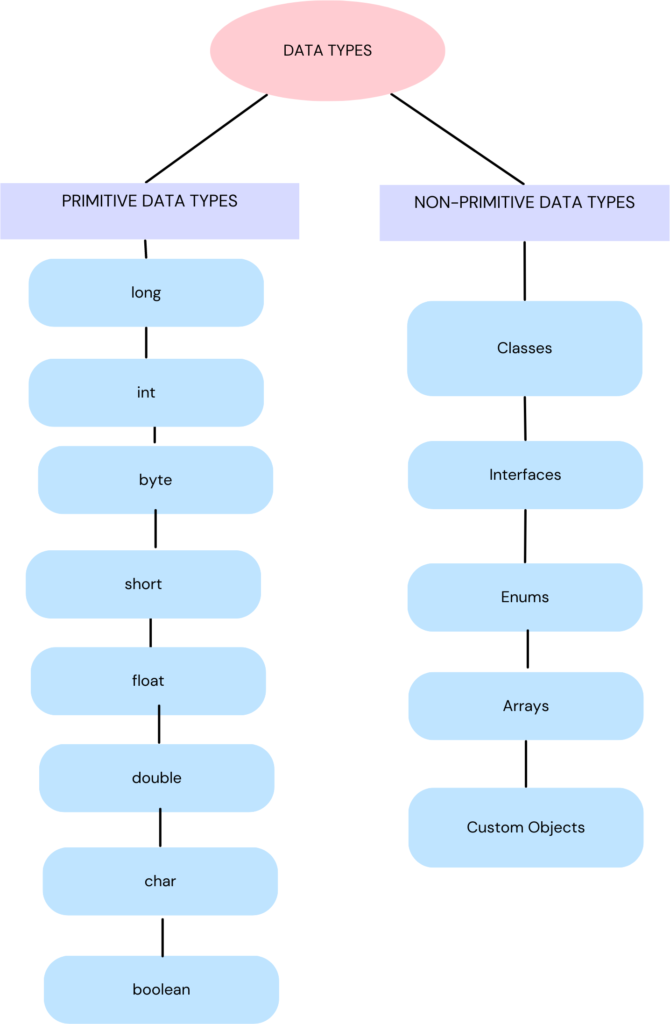“Data types in Java” are the foundational bedrock upon which the realm of Java programming stands. These integral elements determine how information is stored, manipulated, and processed within the code’s dominion. As we set out on a journey to delve into the intricate world of programming, our path is illuminated by the significance of “data types in Java” – a language celebrated for its remarkable versatility and power. Throughout this blog post, our voyage will navigate through the profound depths of these data types, as we uncover their various categories, roles, and the pivotal position they occupy in the creation of precise and efficient software solutions.
Contents of data types in java
WHAT ARE DATA TYPES IN JAVA?
In Java, “data types” refer to the various categories that define the kind of values a variable can hold and the operations that can be performed on those values. They play a crucial role in programming by providing a way to organize and manipulate different types of data, such as numbers, characters, and more complex structures.
There are mainly two data types in java: primitive data types and non-primitive data types.

PRIMITIVE DATA TYPES IN JAVA
Primitive data types in java serve as the foundational building blocks for storing and manipulating simple values. These data types represent basic elements like numbers, characters, and Boolean values. Unlike non-primitive data types, which store references to objects in memory, primitive data types directly hold values. This distinction makes them efficient in terms of memory usage and performance.
There are several primitive data types in java:
- byte:- This data type can hold small whole numbers within the range of -128 to 127. It’s often used when memory usage is a concern.
byte num1=10;
- short:- For slightly larger whole numbers, the short data type accommodates values between -32,768 and 32,767.
short num1=32766;- int:- The int data type is used for regular whole numbers and can store values in the range of -2^31 to 2^31 – 1.
int i=80;- long: When working with even larger whole numbers, the long data type supports values from -2^63 to 2^63 – 1.
long a=253669863;- float: This data type is used for representing single-precision floating-point numbers, which have a broader range than integral types but with reduced precision.
float f=58.56f;- double: The double data type provides double-precision floating-point numbers, offering greater precision compared to float.
double d=5.565656d;- char: The char data type holds single Unicode characters, enabling the representation of letters, digits, and symbols.
char='D';- boolean: The simplest data type, boolean, can take on only two values: true or false. It’s crucial for controlling conditional statements and decision-making in code.
boolean isValid=true;These primitive data types are used extensively in Java programming for fundamental data storage and manipulation. They offer a direct and efficient way to handle basic values without the overhead of more complex data structures. Understanding when and how to use primitive data types is essential for optimizing memory usage and ensuring efficient program execution.
Non-Primitive (Reference) Data types in java
Non-primitive data types in java are also known as reference data types in java. They don’t hold the actual data, but instead, they store references (memory addresses) to the memory locations where the data is stored. These datatypes are used to store complex data structures. Some common examples include:
- Classes: Blueprints for creating objects that contain both data (attributes) and methods. Example: String, Scanner, ArrayList.
- Interfaces: Similar to classes, but they define method signatures without implementations. Example: Runnable, Comparable.
- Enums: A set of predefined constants. Example: enum Day {MONDAY, TUESDAY, WEDNESDAY}.
- Arrays: Collections of similar data elements. Example: int[] scores = {85, 90, 78, 92};
- Custom Objects: User-defined classes that encapsulate data and behavior. Example: class Student { String firstName; int rollNumber; }.
Importance of Data types
Correctly choosing the appropriate datatype for variables is crucial for efficient memory usage and preventing data-related errors. Using the right datatype helps save memory and ensures that operations are performed accurately. For instance, using an int instead of a double when you know you’re dealing with whole numbers can significantly reduce memory consumption.
Conclusion
Data types in java play a fundamental role in defining the nature of data that variables can store and the operations that can be performed on that data. Whether it’s primitive datatypes like int and char, or non-primitive datatypes like arrays and classes, understanding these concepts is essential for writing efficient and error-free Java programs. So, the next time you start coding in Java, make sure to choose your datatypes wisely and harness the full power of this versatile programming language.



